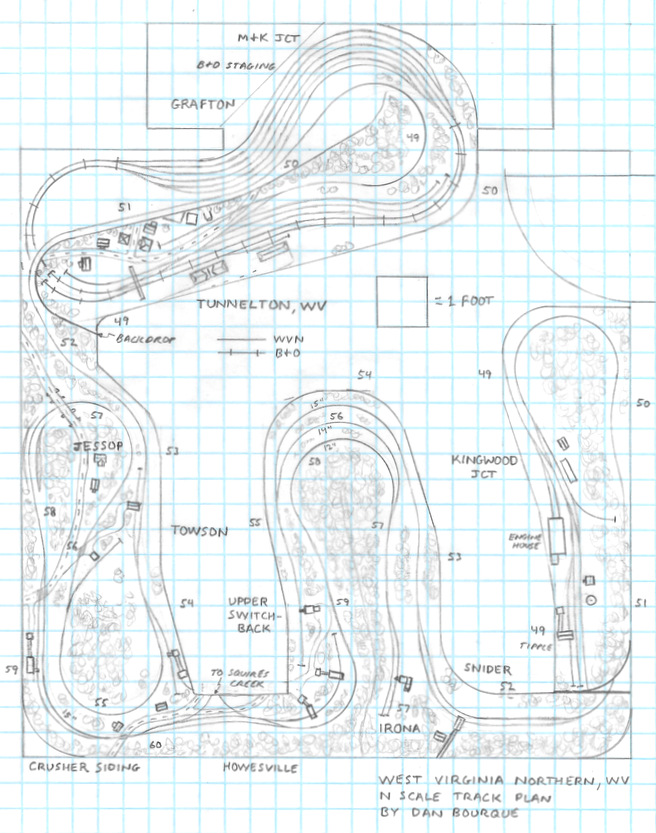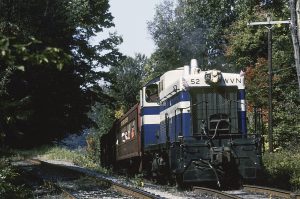- Size: 12′ x 14′
- Scale: N
- Minimum Radius: 12″ (15″ for B&O)
- Minimum Aisle Width: 24″
- Designed by Dan Bourque
 The West Virginia Northern was a short line that ran 11 miles from Tunnelwood, WV to Kingwood, WV. Begun in the 1800s, the WVN was always a small operation, using small locomotives to haul small trains to and from a series of small loaders. For most of its existence, the source of empty hoppers and the outlet for WVN coal was the B&O via a connection at Tunnelton. With so much “small” operation packed in such a small space, almost the entire WVN can be fit into a bedroom layout (at least in N scale).
The West Virginia Northern was a short line that ran 11 miles from Tunnelwood, WV to Kingwood, WV. Begun in the 1800s, the WVN was always a small operation, using small locomotives to haul small trains to and from a series of small loaders. For most of its existence, the source of empty hoppers and the outlet for WVN coal was the B&O via a connection at Tunnelton. With so much “small” operation packed in such a small space, almost the entire WVN can be fit into a bedroom layout (at least in N scale).
The Layout
This track plan represents the entire WVN mainline from Tunnelton to Kingwood along with the iconic town of Tunnelton near the top of the B&O’s Newburg Grade on its double-track main between Keyser and Grafton, WV. The B&O, though a secondary player on the layout, is complete with a double track main, station and freight depot, and double-ended staging yard to allow continuous running of trains (sometimes you just want to see them go in circles) and active interchange with the WVN. The focus of the layout, though, is the WVN main that climbed steeply up and over a ridge, to include the switchback on the Kingwood side. The key features that need to be modeled are the interchange at Kingwood, the switchback, the railroad’s meager facilities at Kingwood Jct, and a handful of the small tipples.
Like the prototype, the WVN is built with steep grades (about 3%) and sharp curves of 12″. This radius is tight, but some of the actual curves on the prototype scale out to about 14.5″–that’s tight for a real railroad! The actual WVN wove back-and-forth up a valley, and I’ve used this along with the tight radii to loop the track back on itself, especially between Towson and Crusher Siding. While not ideal to have the railroad run through a scene more than once, it’s offset by keeping the orientation correct with the hillsides and increasing the mainline run significantly. This trade off is also more palatable because the WVN only ran one train at a time, so you won’t have to worry about two trains in one scene.
This layout represents the WVN in the 1960s after dieselization and when around a dozen loaders were still active (based on 1956 aerial imagery). The only significant trackage NOT modeled is the branch from Howesville to Squires Creek that served a pair of loaders, and a couple of the tipples were left out where the trackage is hidden on the layout (between Tunnelton and Towson and between Snider and Kingwood Jct). Track arrangements for the tipples are based off of topo charts and fuzzy aerial photos, so locations are decent, but there’s a fair chance I’m missing a track or two. This layout could be powered by DC or DCC easily, but a walk-around throttle would be a must.
Operations
This layout is designed for a single operator (tight aisles), but a second operator could be put to work running the B&O. There are enough tracks in staging for a passenger train, a manifest freight, and a coal train (or empty hopper train) in each direction. Perhaps the first train of the way would be a westbound train of empties arriving at Tunnelton from M&K Jct to drop off empties for the WVN in the interchange yard before continuing westward through the tunnels to Grafton. The WVN crew would begin its day at Kingwood Jct. with a set of EMD switchers and a cab. The WVN owned three (including a rare SW1200 with dynamic brakes), and 2-3 were standard most days. The crew would work its way from Kingwood to Tunnelton, picking up loads from the tipples along the way (including one right in Kingwood). Of course, 3 switchers could only haul a handful of loads up the steep grades, so it probably took at least two runs to haul all the loads from the Kingwood end of the switchback. Some loads could be left at Howesville for later pick up, or they could be taken all the way to Tunnelton.
Adding to the challenge is the stub nature of several of the tipples, both facing and trailing point. Coupled with a lack of run-arounds, this turns the entire railroad into a large switching puzzle requiring many moves back-and-forth between Kingwood and Tunnelton to pull all the loads and set all the empties. Like the loads, not all the empties could be hauled up the grade at once, requiring more trips to Tunnelton. At Tunnelton, the WVN crew would need to use the double-ended siding alongside the B&O to run around empties before hauling them upgrade.
In the meantime, the B&O operator could stay busy running occasional freights and coal drags in each direction, along with a couple runs of the passenger trains including the B&O’s National Limited. An occasional eastbound coal drag would stop at Tunnelton to fill out its train with loads from the WVN before continuing on to M&K Jct.
For variety, the loaders of the WVN ebbed and flowed with the times. Some sessions could idle 2-3 of the loaders and run with 2 locomotives to change the pace a bit, while other sessions could simulate a boom with every tipple producing at max and 3 locomotives straining to do all the work. Finally, a late 1990s session could be run with two switchers (50 and 52) and a pair of coaches heading up the switchback from Kingwood to Tunnelton and back again.
Things I Like About this Plan:
- Continuous running option
- Models all key features of an entire railroad
- Realistic operations
- B&O an active secondary player on the layout (variety of equipment and trains)
Things I Don’t Like About this Plan:
- Tight radii
- Trains go through scene more than once
- Short B&O staging tracks
Related Products:





